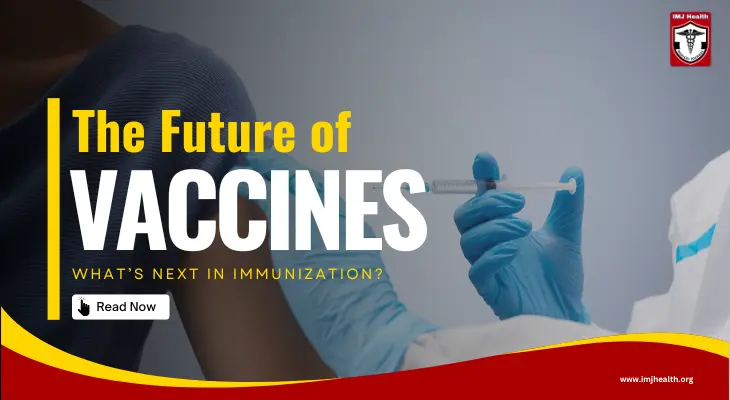The Future of Vaccines: Whats Next in Immunization?

Over the past decade, vaccine technology has advanced dramatically—from mRNA breakthroughs to needle-free delivery methods. This blog explores the future of immunization, highlighting next-gen vaccine platforms, AI-driven research, and personalized vaccine development. Discover what’s coming next in the fight against infectious and chronic diseases.
The last 50 years have transformed vaccine science, but the next decade promises even bigger breakthroughs. Researchers are working on revolutionary approaches to prevent diseases more effectively, safely, and conveniently. Here’s a detailed look at what’s coming next in vaccine development.
1. Universal Vaccines: One Shot for Multiple Strains:
The endless game of catch-up with mutating viruses like influenza and coronaviruses may soon be over. Universal vaccines represent a paradigm shift in immunization, targeting conserved regions of viruses that remain stable across different strains. This groundbreaking approach could eliminate the need for seasonal shots and provide lasting protection against entire families of pathogens.
Why We Need Them:
Many viruses, like the flu and coronaviruses, constantly mutate, requiring new vaccines every year. Universal vaccines aim to target unchanging parts of these viruses, providing long-lasting protection.
Progress So Far:
- Flu – Scientists are testing vaccines that focus on the "stem" of the hemagglutinin (HA) protein, which doesn’t change much between strains.
- HIV & Coronaviruses – Researchers are exploring mosaic vaccines that combine pieces of different virus strains to trigger broad immunity.
Challenges:
- Viruses evolve rapidly, making it hard to find stable targets.
- Clinical trials take years to confirm long-term protection.
Expected Timeline: Some universal flu vaccines are already in Phase 3 trials and could be available by 2030.
2. Cancer Vaccines: Training the Immune System to Fight Tumors:
Vaccines are breaking free from their traditional role of preventing infections to become powerful weapons against cancer. Unlike conventional treatments that attack tumors directly, these next-generation vaccines teach the body's own immune system to recognize and destroy cancer cells with precision. This emerging field is turning decades of oncology research into potentially life-saving therapies.
How They Work:
Unlike traditional vaccines that prevent infections, cancer vaccines help the immune system recognize and attack cancer cells.
Types in Development:
- ✔ Preventive Vaccines (Like HPV vaccine for cervical cancer)
- Target viruses linked to cancer (e.g., EBV vaccine for lymphoma in trials).
- ✔ Therapeutic Vaccines (For treating existing cancer)
- Personalized mRNA vaccines (BioNTech & Moderna are testing these for melanoma).
- Neoantigen vaccines – Custom-made for a patient’s unique tumor mutations.
Recent Success:
- In 2023, the mRNA melanoma vaccine (combined with immunotherapy) showed 44% lower risk of recurrence in trials.
Expected Timeline: First approvals for therapeutic cancer vaccines could come by 2025-2030.
3. Needle-Free Vaccines: Painless Alternatives:
The fear of needles and cold-chain logistics challenges may soon become relics of vaccine history. Innovative delivery systems - from nasal sprays to dissolvable patches - are making immunization more accessible and comfortable than ever before. These pain-free alternatives could revolutionize vaccination rates, especially among children and needle-averse populations.
Why They Matter:
- No needles = better compliance (especially for kids).
- Easier to distribute in remote areas.
Leading Technologies:
| Method | How It Works | Status |
|---|---|---|
| Nasal Sprays | Delivers vaccine through the nose | FluMist (approved), COVID-19 in trials |
| Patch Vaccines | Dissolvable microneedles on a patch | COVID-19 & flu patches in Phase 2 |
| Oral Vaccines | Swallowed like a pill | Polio (already used), cholera vaccine |
Expected Timeline: Patch vaccines could be widely available by 2026-2028.
4. DNA & RNA Vaccines Beyond COVID:
The success of mRNA vaccines against COVID-19 was just the beginning of a nucleic acid vaccine revolution. Scientists are now adapting this platform to combat everything from ancient scourges like HIV to emerging threats like Nipah virus. These genetic vaccines offer unprecedented flexibility in responding to both chronic and pandemic-level health threats.
Expanding mRNA Technology:
After COVID-19 proved mRNA works, scientists are now testing it for:
- HIV – Early trials show promising immune responses.
- Zika & Nipah viruses – Preclinical studies underway.
- Autoimmune diseases – Like multiple sclerosis (MS).
DNA Vaccines (Next-Gen mRNA?):
- More stable than mRNA (don’t need ultra-cold storage).
- In trials for HIV, rabies, and Lyme disease.
Expected Timeline: 2-3 more mRNA/DNA vaccines (e.g., HIV) may be approved by 2030.
5. AI & Faster Vaccine Development:
Artificial intelligence is supercharging every stage of vaccine development, from initial design to global distribution. By analyzing vast datasets and predicting viral evolution, AI tools are helping researchers shave years off traditional development timelines. This technological synergy is creating a new era where vaccines can be designed virtually before a pathogen even becomes a global threat.
How AI Helps:
- Predicts outbreaks (e.g., Google DeepMind’s AlphaFold models virus structures).
- Designs vaccines in hours (e.g., COVID-19 spike protein was optimized using AI).
Future Possibilities:
- "Plug-and-Play" Vaccines – AI designs a vaccine as soon as a new virus is sequenced.
- Real-time side effect monitoring – AI tracks vaccine safety globally.
Challenges Ahead:
Despite progress, hurdles remain:
- Cost – mRNA vaccines are expensive to make.
- Global equity – Poor countries still lack access to basic vaccines.
- Public trust – Misinformation slows adoption.
The future of vaccines is faster, smarter, and more personalized. From one-shot universal vaccines to cancer-fighting mRNA shots, science is turning yesterday’s impossibilities into tomorrow’s cures.
What excites you most about future vaccines? Share your thoughts below!
References (Sources):
- Nature Reviews Immunology (2023) – Universal Flu Vaccines
- WHO – Cancer Vaccine Landscape
- MIT Technology Review – AI in Vaccine Design
Frequently Asked Questions?:
1. What are the major future trends in vaccine development?
Some key trends include mRNA-based vaccines, needle-free delivery, universal vaccines (e.g., for influenza), AI-assisted vaccine design, and thermostable vaccines that don’t require cold storage.
2. How will mRNA technology impact future vaccines?
mRNA technology allows scientists to create vaccines faster and more precisely. It played a big role in COVID-19 and is now being researched for flu, cancer, HIV, and other diseases.
3. What is a universal vaccine?
A universal vaccine is designed to protect against all strains of a virus (like flu) instead of being updated yearly. This would reduce the need for frequent boosters and improve global protection.
4. Will vaccines become easier to store and transport?
Yes. Future vaccines are being designed to be thermostable, meaning they can be stored at room temperature. This makes them easier to distribute, especially in remote or low-income regions.
5. Are vaccines being developed for diseases like cancer or Alzheimer’s?
Yes. Researchers are working on therapeutic vaccines to treat diseases like cancer, Alzheimer’s, and autoimmune disorders by training the immune system to fight disease cells.
6. What is AI’s role in next-gen vaccine development?
Artificial Intelligence helps scientists identify the best antigen targets faster, simulate immune responses, and design safer, more effective vaccines in a shorter time.
7. Will we see more personalized vaccines in the future?
Yes. Personalized or precision vaccines are being developed using genetic and immune profiling. These are tailored to individual or population-level needs for better immune responses.
8. Are there concerns about the safety of new vaccine technologies?
All vaccines, including newer types like mRNA or viral vector vaccines, go through strict testing for safety and effectiveness. Regulatory oversight remains strong for any new platform.
9. How is the global community preparing for future pandemics with vaccines?
Efforts are underway to create “prototype” vaccines for potential future threats and to develop vaccine platforms that can be quickly adapted in case of new outbreaks.
10. What skills or fields are important for students interested in vaccine research?
Relevant fields include immunology, molecular biology, bioinformatics, pharmaceutical sciences, and epidemiology. Data science and AI are also becoming important in modern vaccine development.
Contact Medical Journal: IMJ Health:
- Website: www.imjhealth.org
- Editor-in-Chief: Dr. Kusum Lata Gaur | MBBS, MD(PSM), CIC (IGNOU), PGCHFWM
(NIHFW) (WHO Fellow IEC)
Professor, PSM & Member of Research Review Board | SMS Medical College, Jaipur (Rajasthan) India - Editor-in-Chief Email ID: info@imjhealth.org
- General Support Email: info.imjh@gmail.com
- Contact us on WhatsApp: Chat Now : +91-7665235235
If you are working on drug discovery, clinical trials, or pharmaceutical technology, consider submitting your research to IMJ Health to reach a wider audience and make an impact in the field of medicine.

 October 2025 Articles
October 2025 Articles Submit Article
Publication Fee
Research Areas
Guidelines for Authors
Process of
Publication
Journal Importance
Journal Indexing
Journal Polices
Digital
Identification Number
FAQs
Submit Article
Publication Fee
Research Areas
Guidelines for Authors
Process of
Publication
Journal Importance
Journal Indexing
Journal Polices
Digital
Identification Number
FAQs
| Citation Indices | All | Since 2019 |
| Citation | 280 | 209 |
| h-index | 7 | 7 |
| i10-index | 3 | 1 |
| Acceptance Rate (By Year) | |
| Year | Percentage |
| 2024 | 8.17% |
| 2023 | 10.84% |
| 2022 | 9.14% |
| 2021 | 11.26% |
| 2020 | 11.8% |
| 2019 | 10.3% |
| 2018 | 8.65% |
| 2017 | 12.9% |
| 2016 | 10.9% |
| 2015 | 12.5% |
